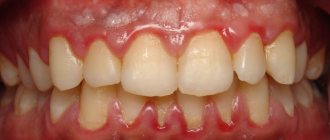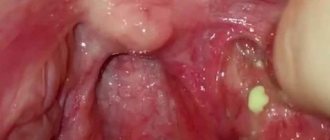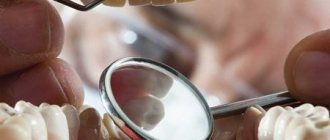White plaque on the gums can be a symptom of candidiasis, a disease caused by a fungus of the genus Candida. Under the influence of a fungal infection, stomatitis develops. First, multiple cheesy white rashes appear on the surface of the cheeks, tongue, palate and gums. Gradually they begin to grow. As the lesions grow, they merge and a film forms in the mouth.
At the beginning of the disease, plaque can be scraped off. But in the place where it was removed, small ulcers remain. When the disease is advanced, the whitish film can no longer be scraped off. The patient feels serious discomfort. Dryness, burning, pain, and a metallic taste appear in the mouth. In the advanced stage there are systemic symptoms. The head begins to hurt, the patient complains of lethargy and weakness, and the temperature rises.
Candida is an opportunistic microflora. They live in the oral cavity of any person. As long as their number is within normal limits, pathological conditions do not develop. If candida begins to multiply quickly, they provoke candidiasis.
Why does light plaque form on the gums and what does it mean?
Ideally, the gums should have a uniform pinkish color. If suspicious white spots appear on the oral mucosa, you should be wary - most often they indicate the presence of some pathological processes in the body. The reason for the formation of white plaque on the gums may be a low level of hygiene or, for example, a whitening procedure. However, a similar symptom can also be provoked by a serious illness - leukoplakia, abscess, oncology. Read further in this article about possible causes of the problem and ways to solve it.
Light plaque on the gums is not a reason to panic
Plaque on the oral mucosa is a breeding ground for pathogenic bacteria. In the absence of any pathological processes in the body, such a symptom may indicate insufficient hygiene. Usually natural plaque can be detected in the morning after waking up, in which case it can be easily removed with a regular toothbrush and paste. Its presence on the tongue and gums is a completely natural and normal phenomenon, which provides a certain degree of protection of the oral cavity from pathogenic microflora. However, if a person does not systematically brush his teeth and take care of his oral cavity, the plaque on the teeth near the gums will very soon begin to harden and eventually turn into tartar, which can only be removed in the dentist’s office.
White plaque on the gums, why does it occur?
Another question is if you can’t remove the film yourself. In such cases, it usually has a dense consistency and can appear either in the form of a continuous covering or in the form of plaques. This symptom indicates the presence of any pathological processes in the oral cavity or in the body, so in this case you should definitely consult a doctor. It will be possible to cope with the problem only after making an accurate diagnosis, and any attempts to eliminate plaque on your own will not lead to the desired results, if they do not aggravate the situation at all.
Treatment methods
Before consulting a doctor, you should not self-medicate or use folk remedies, as this can only speed up rejection.
Comprehensive treatment of reimplantitis at an early stage may include:
- crown removal,
- opening the formation, removing pus, treating tissue with antiseptics or exposure to a laser beam,
- cleaning and reinstallation of the crown,
- taking antibiotics, anti-inflammatory and painkillers.
If the inflammatory process is advanced, the doctor will have to remove the implant. After this, the cavity is cleared of pus and medications are prescribed that will help stop the inflammation, relieve pain and swelling. After final restoration, reimplantation is performed. If the volume of bone tissue is not enough to reinstall the prosthesis, bone grafting is first prescribed.
To prevent relapse of reimplantitis, you need to:
- quit smoking
- use brushes, pastes and rinses recommended by your doctor for oral care,
- Regularly undergo preventive examinations at the dentist and have your teeth professionally cleaned.
What other symptoms may appear?
If the issue is not a low level of oral hygiene, and plaque cannot be removed on your own, we are talking about a specific pathological condition. In this case, patients often experience associated symptoms. Among the most common signs of the problem are bad breath, itching, swelling and redness of soft tissues, the appearance of small ulcers and other growths on the gums. To prescribe the necessary treatment, the doctor first needs to examine the patient’s oral cavity, take into account accompanying complaints, and, if necessary, take tests and scrapings.
Only tests can determine the true cause of the problem.
Are white spots on the gums a symptom of rejection?
The following signs indicate the initial stage of rejection:
- pain around the operated area;
- edematous hyperemic mucosa;
- bleeding;
- bad breath.
As the destructive process progresses, the symptoms increase and include:
- pin mobility;
- severe pain syndrome;
- pronounced hyperplastic changes in the gingival contour;
- periodontal pockets;
- fistulous tracts, the purulent contents of which come to the surface through the resulting white sac.
The associated infection is manifested by an increase in body temperature, intoxication, and deterioration of the general condition. Typically, patients with implant failure have regional lymphadenitis.
The appearance of white dots at the site of the implanted titanium root may indicate a purulent process and the presence of fistula tracts , which are signs of rejection.
Why an implant may not take root after installation
- Unprofessionalism or mistake of the implantologist . Lack of experience, inattention, and negligence can lead to serious consequences.
- Poor quality implantation system . Working with direct suppliers allows clinics to avoid purchasing low-quality counterfeits. Small private dentistry does not always have this opportunity, so there is no confidence in the originality of the designs. In addition, high-quality materials are required for manufacturing - the implant cannot be cheap.
- Failure to comply with doctor's recommendations . Any work of a specialist can be reduced to zero by the patient’s incorrect actions during the engraftment period. Deteriorating health also negatively affects implants—rejection can occur even several years after surgery.
What to do to prevent the appearance of white plaque after implantation
You can minimize the risk of white spots and the development of peri-implantitis by following the recommendations of your implantologist.
- Avoid solid food for the first three days after surgery.
- No smoking.
- Massage your gums regularly. This will relieve swelling and improve blood circulation.
- Drink more water.
- Brush your teeth with a soft-bristled brush and children's toothpaste. Do not touch the seam area. Use an irrigator or floss.
- Carefully remove plaque on the gums with a cotton swab.
- Take all prescribed medications and perform the necessary procedures.
How to save an implant during rejection
Correct treatment tactics can stop inflammation within 10-14 days. In case of rejection due to medical error, qualified reimplantation will help. Failure to properly care for the operated area gives an unfavorable prognosis. Reimplantation is not relevant here.
Treatment consists of two stages:
- Medication course. Eliminates the inflammatory process. It is possible to modify the superstructure to redistribute the load on the implant.
- Surgical curettage of the source of infection. Ends with a course of antibiotics and antiseptic rinses.
Timely consultation with a doctor allows you to save the implant. In advanced cases, when treatment does not make sense, the implant is removed. A repeated implantation procedure is possible in a month or two, no later, since in the absence of load on the tissues, their recession begins.
Common causes of white plaque on the gums
So, why does light plaque appear on the teeth, near the gums and in other areas of the oral mucosa and what does this mean? As noted above, the most common cause of the problem is insufficient care. Among other common provoking factors, experts highlight the appearance of tumors on the gums, the consequences of dental procedures and exacerbation of diseases. Let's look at all these reasons in more detail.
Factors leading to symptoms in adults
Light plaque on the mucous membrane in adults is a fairly common occurrence after professional whitening. Also, a thin film on the gum can form after rinsing the mouth with an antiseptic. This is a temporary phenomenon that disappears on its own within a few days. Also, a similar problem can arise due to a lack of certain minerals and vitamins in the body after tooth extraction. In the latter case, the symptom in question becomes a complication that occurs due to infection of the wound. In such a situation, the gum tissue also swells, is covered with a light film, and the person suffers from severe pain.
So, the most common pathological conditions leading to the formation of whitish plaque on the gums are listed below:
- stomatitis: in addition to plaque on the mucous membrane, inflamed areas with ulcers and erosions appear,
The photo shows candidiasis in the mouth - leukoplakia: soft tissues thicken, and white plaques appear on the mucous membrane itself, which gradually harden1,
- candidiasis (thrush): plaque is characterized by a cheesy consistency, is easily removed, but without treatment it soon forms again,
- Oncology of the gums: in this case, a hard plaque is formed, which most often appears in the form of numerous nodules.
“When I saw a thick coating on the child’s gums, I was also very scared. If it doesn't come off after rinsing, don't try to remove it with a brush or your finger. We immediately went to the children's dentist, and the doctor immediately determined that we had stomatitis. We were prescribed rinses with antiseptics, and in just a week everything went away. The main thing here is to immediately run to the doctor, and it’s better not to do anything on your own.”
Nadezhda P.R., Krasnoyarsk, from correspondence on the woman.ru forum
White spots on the mucous membrane can also indicate the presence of a cyst - penetrating into the canals, the infection leads to the accumulation of purulent masses at the apex of the tooth. The gum area turns white, and the person experiences acute pain when the sore spot is mechanically irritated. Wen and fistulas also often lead to the formation of plaque.
For what reasons can it appear in a child’s mouth?
The occurrence of a similar problem in children, including infants, usually indicates the development of candidiasis (thrush). The pathology is provoked by a fungus of the Candida species, which, against the background of a weakened immune system or other provoking factor, quickly spreads in the oral cavity. In this case, the child does not experience serious discomfort or pain, but the disease necessarily requires medical intervention.
Stomatitis is common in infants
Among other common causes of plaque in a child’s mouth, experts identify the following conditions:
- measles - white spots with a reddish edge,
- teething - the appearance of a light area on the gum,
- stomatitis – the main cause of the problem is most often insufficient oral hygiene or an incorrectly selected diet. A similar pathology is diagnosed in children, adolescents and adults.
It is also worth noting that a white film on the inner surfaces of the oral cavity may appear due to a lack of calcium and vitamins in the body. In any case, before starting symptomatic treatment, it is necessary to determine the source of the problem.
What is a white coating on a wound?
Two to three hours after extraction of the problem unit, a dark clot of blue, black or red color forms in the alveolar socket. This is a bloody secretion that forms the primary barrier to protect the socket from external elements and pathogenic bacteria. After several days, a coating appears on the surface of the clot - with a characteristic yellow, white or gray tint, externally resembling suppuration, and having a specific odor. However, this is not actually pus, but a special protein-based compound known in dentistry as fibrin.
The structure of the plaque can vary from soft to very dense. Preserving the integrity of the film allows for the development of natural processes beneath its surface:
- Gradual resorption of the blood clot:
- Reducing the diameter of the alveolar socket;
- Displacement of new cells - osteoblasts - to the central part;
- Closing the wound with regenerating gum tissue.
The formation of fibrinous plaque is a necessary process, important from the point of view of restoration of the body in the period after tooth extraction.
How is treatment carried out?
Treatment should begin with oral hygiene, and only after cleaning proceed to the main therapeutic measures. The choice of a specific treatment scenario directly depends on what specific problem the doctor will have to deal with. Obviously, if the cause of plaque is poor hygiene or teeth whitening, to get rid of the film on the gums, it is enough to rinse your mouth thoroughly - with plain water or chamomile infusion.
Chamomile infusion is great for rinsing
To treat stomatitis, I usually prescribe antiseptics and anti-inflammatory drugs, however, even in this case, much will depend on the form of the disease. If the cause of all the troubles is a fistula, then it will have to be opened surgically and the cavity cleared of purulent exudate.
On a note! Fungal infections are treated with special antifungal drugs: Nystatin, Clotrimazole, Fluconazole. Also, for a while, the patient will have to give up salty, bitter and acidic foods.
It is extremely important to start treatment for leukoplakia on time, since this disease often becomes a harbinger of oncology. In order to eliminate white plaques, an integrated approach is used - therapy is aimed at eliminating provoking factors. As part of the treatment, vitamin complexes are prescribed, and the affected areas are removed using an electric knife, laser device or radio waves. It is worth noting that liquid nitrogen is not used here because it leaves behind deep scars.
Why don't implants take root?
Doctors identify several main factors that provoke the development of reimplantitis. These include:
- insufficient diagnostics before starting prosthetics,
- low quality of materials from which the pins and crowns are made,
- violation of installation rules,
- non-compliance with the rules of oral care after surgery,
- smoking and other bad habits,
- decreased immunity.
To avoid rejection, you need to carefully choose a clinic and a doctor, and strictly follow all his recommendations before and after the intervention. Rejection can begin either a few days or several years after installation, so it is important to carefully monitor the condition of your oral cavity and undergo regular preventive examinations with your dentist.
What can be done for prevention
The key condition that will help avoid not only the appearance of white bacterial plaque, but also most oral diseases, is regular and proper hygiene. You should brush your teeth at least twice a day, and after meals you should rinse your mouth with plain water or a special pharmaceutical product - these are the basic principles of maintaining oral hygiene. It is also worth minimizing the risk of injury to teeth and soft tissues by external factors. To do this, try to avoid sudden temperature changes when eating. For normal functioning of the body as a whole, it is recommended to take multivitamin complexes from time to time.
Regular oral hygiene will help avoid problems
The appearance of a white film on the mucous membrane does not always indicate the presence of any problem in the body. Most often, this is just a consequence of insufficient oral hygiene. However, if after several attempts to rinse your mouth thoroughly the plaque still does not disappear, you should definitely consult a doctor.
- Anisimova, I.V. Clinic, diagnosis and treatment of diseases of the mucous membrane of the mouth and lips, 2008.
How not to damage white plaque after wisdom tooth removal
To eliminate the risk of complications and speed up the recovery process, you need to follow the rules of behavior after tooth extraction:
- do not eat or drink for 3 hours after surgery;
- stop smoking and drinking alcohol for a while;
- do not heat the cheek and gums, avoid overheating;
- for the first 24 hours, do not rinse your mouth or brush your teeth;
- Do not go to the bathhouse for a week, do not play sports.
Smoking is contraindicated, as it provokes vasospasm: the bleeding stops too quickly, the blood clot is not formed enough. Hot drinks, warming the cheek, sports training and visiting a bathhouse cause overheating of the body and dilation of blood vessels, which can cause re-bleeding, opening and infection of the wound.
Rinsing and brushing the mouth are acceptable 24 hours after tooth extraction, but they should not be overly vigorous. Hygienic procedures must be moderate so that the blood clot remains in the cavity and the subsequently formed fibrinous protective layer is not damaged. During the recovery period, food should be chewed only on the non-operated side of the jaw.
If you have a fever and severe pain in the first few days after tooth extraction, you can take Paracetamol - this will help reduce discomfort and improve your well-being.









